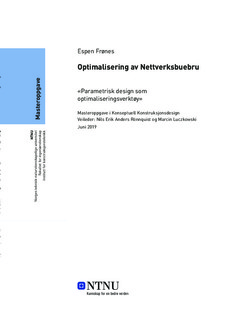| dc.contributor.advisor | Rönnquist, Nils Erik Anders | |
| dc.contributor.advisor | Luczkowski, Marcin | |
| dc.contributor.author | Frønes, Espen | |
| dc.date.accessioned | 2019-10-19T14:01:25Z | |
| dc.date.available | 2019-10-19T14:01:25Z | |
| dc.date.issued | 2019 | |
| dc.identifier.uri | http://hdl.handle.net/11250/2623346 | |
| dc.description.abstract | Denne masteroppgaven benytter seg av parametrisk design for å automatisere optimaliseringen av en nettverksbuebru gitt radiell staggeometri ved hjelp av programvarene Dynamo, Robot Structures Analysis og Excel. Samt å benytte en manuell versjon av samme kode for videre analyse av optimale modeller.
Etableringen av den automatiske og den manuelle parametriske modellen er på linje med optimaliseringen de utfører en del av oppgaven og drøftes med bakgrunn i funksjon og kvalitet
Den automatiserte parametriske modellen har utført analyse av 2160 nettverksbuebruer innenfor valgt parameterspekter med tilhørende resultathenting og videre vekting av resultatene for 9 utvalgte punkter. Resultatet fra den automatiserte optimaliseringen og vektingen verifiseres ved sammenligning med manuelle analyser utført under Analyse I, da med bakgrunn i resultatenes tendenser å ikke nødvendigvis eksakt verdi. Dette har vist seg å gi de faktiske optimale modeller gitt at vektingen utføres for grupper av modeller og ikke totalt antall modeller.
Den automatiske parametriske modellen har vist seg å levere korrekte verdier på en oversiktlig og forutsigbar måte, men er sårbar for forandringer i geometri som resulterer i differanser i ID-nummerering på tvers av Dynamo og RSA. En annen svakhet denne samhandlingen mellom programvare har er at når Dynamo mellom hver runde produserer en ny brugeometri vil RSA sitt internminne på grunn av angrefunksjonen i programmet bli fullt, noe som resulterer i en stadig økende beregningstid.
Denne sammensetning av programvare gitt automatisering setter også begrensninger for konstruksjonens lastsituasjon. Det kan kun benyttes én lastkombinasjon og den kan ikke inneholde konstruksjonens programmerte egenlast. Dermed må den lastkombinasjonen med størst sjanse for å produsere ønskede resultater velges, samt at egenlasten i denne lastkombinasjonen må påføres som linjelaster.
Det er videre utført en dimensjonering og sammenligning av 28 modeller valgt ut med hensikten å fremvise effekten av variablene høyde av buen og antallet stag. Dimensjoneringen og sammenligningen med bakgrunn i kapasitetsanalyse og knekkingsanalyse er fordelt på Analyse I og II. Hvor Analyse I tar utgangspunkt i modellene slik de gikk gjennom den automatiserte optimaliseringen og hvor Analyse II videre optimaliserer modellenes tverrsnitt, det utføres også dimensjonering av staginnfestninger og løfteører for modell 2147.
Resultatet av disse to analysene har vist seg å være mindre påvirkning av variasjon i høyde og antall stag enn forventet, hvor differansene i tverrsnitt først blir gjeldene for modellene med høyde og/eller antall stag i nedre del av spekteret. | |
| dc.description.abstract | This master thesis makes use of parametric design to automate the optimization of a network arch bridge given radial cable geometry using the following software’s, Dynamo, Robot Structural Analysis and Excel. And using a manual version of the same code to further analyze the optimized models.
Both the establishment of the automate and manual parametric model and the optimization they produce is an equal part of the thesis and will be discussed on their function and quality.
The automated parametric model has executed an analysis for 2160 network arch bridges within the spectrum of parameters with the associated result scripting and weighting of the results for the 9 result groups. The verification of the results from the automatic optimization and the weighting is done by comparison with the manual analysis executed in Analysis I, based on tendencies of the results and not necessarily exact values. This has shown to produce true optimized models given that the weighting is done by groups of models not the total amount of models.
The automatic parametric model has shown that it delivers the correct values in a practical and predictable way, but is vulnerable to change in geometry that results in Id-number difference between Dynamo and RSA. Another weakness this combination of software has is that every time Dynamo produce a new bridge model the internal memory in RSA will fill up. This is a result of the redo function that makes RSA store a large number of models internally and lead to a continuous increase in calculating time.
This combination of software given automatization also limits the load situation for the structure. There can only be used one load combination and that load combination cannot have the structures programed deadload included. As a result of this the choice of load combination has to be done with the wanted results in mind, so that the analysis has the biggest chance to produce the wanted results and the deadload has to be added to the structure as line loads.
It is further carried out design and comparison of 28 models chosen with the purpose to display the effect of the changing arch height and the number of struts. Design and comparison based on capacity analysis and critical load analysis is done in two steps, Analysis I and II.
Analyze I use the models as they were in the automated optimization without any edits and Analyze II further optimize the models cross section. There is also done design of the strut connections and the lifting lug of model 2147.
The result of these two analyzes has shown to be less affected by the variation of height and number of struts then the author expected, where the difference in cross section first apply to the models with height and/or number of struts in the lower part of the parameter spectrum. | |
| dc.language | nob | |
| dc.publisher | NTNU | |
| dc.title | Optimalisering av Nettverksbuebru «Parametrisk design som optimaliseringsverktøy» | |
| dc.type | Master thesis | |
